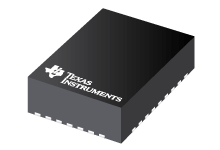Datasheet Texas Instruments LMZ30606
| Manufacturer | Texas Instruments |
| Series | LMZ30606 |

SIMPLE SWITCHERВ® 2.95V to 6V, 6A Power Module in Small QFN Package
Datasheets
LMZ30606 6-A SIMPLE SWITCHERВ® Power Module with 2.95V-6V Input in QFN Package datasheet
PDF, 1.5 Mb, Revision: A, File published: Jun 7, 2017
Extract from the document
Prices
Status
| LMZ30606RKGR | LMZ30606RKGT | |
|---|---|---|
| Lifecycle Status | Active (Recommended for new designs) | Active (Recommended for new designs) |
| Manufacture's Sample Availability | Yes | No |
Packaging
| LMZ30606RKGR | LMZ30606RKGT | |
|---|---|---|
| N | 1 | 2 |
| Pin | 39 | 39 |
| Package Type | RKG | RKG |
| Industry STD Term | B1QFN | B1QFN |
| JEDEC Code | R-PQFP-N | R-PQFP-N |
| Package QTY | 500 | 250 |
| Carrier | LARGE T&R | SMALL T&R |
| Device Marking | 54618 | LMZ30606 |
| Width (mm) | 9 | 9 |
| Length (mm) | 11 | 11 |
| Thickness (mm) | 2.8 | 2.8 |
| Pitch (mm) | .9 | .9 |
| Max Height (mm) | 2.9 | 2.9 |
| Mechanical Data | Download | Download |
Parametrics
| Parameters / Models | LMZ30606RKGR | LMZ30606RKGT |
|---|---|---|
| Iout(Max), A | 6 | 6 |
| Operating Temperature Range, C | -40 to 85 | -40 to 85 |
| Package Size: mm2:W x L, PKG | 39B1QFN: 99 mm2: 9 x 11(B1QFN) | 39B1QFN: 99 mm2: 9 x 11(B1QFN) |
| Package Type | QFN | QFN |
| Regulated Outputs | 1 | 1 |
| Soft Start | Adjustable | Adjustable |
| Special Features | EMI Tested,Enable,Frequency Synchronization,Power Good,Remote Sense,Tracking | EMI Tested,Enable,Frequency Synchronization,Power Good,Remote Sense,Tracking |
| Switching Frequency(Max), kHz | 2000 | 2000 |
| Switching Frequency(Min), kHz | 500 | 500 |
| Switching Frequency(Typ), kHz | 1250 | 1250 |
| Vin(Max), V | 6 | 6 |
| Vin(Min), V | 2.95 | 2.95 |
| Vout(Max), V | 3.6 | 3.6 |
| Vout(Min), V | 0.8 | 0.8 |
Eco Plan
| LMZ30606RKGR | LMZ30606RKGT | |
|---|---|---|
| RoHS | Not Compliant | Not Compliant |
Application Notes
- Adjusting LMZ3 Output Voltage with LM10010/1PDF, 87 Kb, File published: Feb 11, 2014
ThisapplicationnoteoutlinesthemethodstopairanLMZ3powermodulewithanLM10010/1VIDvoltageprogrammertoadjusttheoutputvoltage.TheLMZ3powermoduleisaneasy-to-useintegratedpowersolutionwhichcombinesaDC/DCconverterwithpowerMOSFETs,ashieldedinductor,andpassivecomponentsintoalowprofileQFNpackage,whilest - Working With QFN Power Modules (Rev. A)PDF, 1.7 Mb, Revision: A, File published: Jun 8, 2017
TexasInstrumentsQuadFlatpackNo-lead(QFN)powermodulesallowfor boardminiaturization,and holdseveraladvantagesoverotherpowermodulepackages.The QFNpackageshavehigherpowerdensity,asmallerroutingarea,improvedthermalperformance,and improvedelectricalparasitics.Additionally,theabsenceof externalleadseliminatesbent-leadconc - Soldering Requirements for BQFN Packages (Rev. B)PDF, 737 Kb, Revision: B, File published: Jun 8, 2017
This documentoutlinesthe solderingrequirementsfor the TPS84and LMZ3devicefamilies - Uninterruptible Synchronization Clock CircuitPDF, 74 Kb, File published: Nov 22, 2013
- Understanding and Applying Current-Mode Control TheoryPDF, 409 Kb, File published: Aug 19, 2007
- AN-1889 How to Measure the Loop Transfer Function of Power Supplies (Rev. A)PDF, 2.7 Mb, Revision: A, File published: Apr 23, 2013
This application report shows how to measure the critical points of a bode plot with only an audiogenerator (or simple signal generator) and an oscilloscope. The method is explained in an easy to followstep-by-step manner so that a power supply designer can start performing these measurements in a shortamount of time. - AN-643 EMI/RFI Board Design (Rev. B)PDF, 742 Kb, Revision: B, File published: May 3, 2004
Application Note 643 EMI/RFI Board Design - AN-1149 Layout Guidelines for Switching Power Supplies (Rev. C)PDF, 82 Kb, Revision: C, File published: Apr 23, 2013
When designing a high frequency switching regulated power supply layout is very important. Using agood layout can solve many problems associated with these types of supplies. The problems due to a badlayout are often seen at high current levels and are usually more obvious at large input to output voltagedifferentials. Some of the main problems are loss of regulation at high output current - AN-1520 A Guide to Board Layout for Best Thermal Resistance for Exposed Packages (Rev. B)PDF, 9.2 Mb, Revision: B, File published: Apr 23, 2013
This thermal application report provides guidelines for the optimal board layout to achieve the best thermalresistance for exposed packages. The thermal resistance between junction-to-ambient (ОёJA) is highlydependent on the PCB (Printed Circuit Board) design factors. This becomes more critical for packageshaving very low thermal resistance between junction-to-case such as exposed pad TSSOP - AN-2155 Layout Tips for EMI Reduction in DC/ DC Converters (Rev. A)PDF, 3.6 Mb, Revision: A, File published: Apr 23, 2013
This application note will explore how the layout of your DC/DC power supply can significantly affect theamount of EMI that it produces. It will discuss several variations of a layout analyze the results andprovide answers to some common EMI questions such whether or not to use a shielded inductor. - AN-1229 SIMPLE SWITCHER PCB Layout Guidelines (Rev. C)PDF, 374 Kb, Revision: C, File published: Apr 23, 2013
This application report provides SIMPLE SWITCHER™ PCB layout guidelines. - AN-2162 Simple Success With Conducted EMI From DC-DC Converters (Rev. C)PDF, 2.5 Mb, Revision: C, File published: Apr 24, 2013
Electromagnetic Interference (EMI) is an unwanted effect between two electrical systems as a result ofeither electromagnetic radiation or electromagnetic conduction. EMI is the major adverse effect caused bythe application of switch-mode power supplies (SMPS). In switching power supplies EMI noise isunavoidable due to the switching actions of the semiconductor devices and resulting disconti - Semiconductor and IC Package Thermal Metrics (Rev. C)PDF, 201 Kb, Revision: C, File published: Apr 19, 2016
- QFN and SON PCB Attachment (Rev. B)PDF, 821 Kb, Revision: B, File published: Aug 24, 2018
- Input and Output Capacitor SelectionPDF, 219 Kb, File published: Sep 19, 2005
Model Line
Series: LMZ30606 (2)
Manufacturer's Classification
- Semiconductors> Power Management> Power Modules> Non-Isolated Module> Step-Down (Buck) Module
